Good morning everyone! Recently, I stumbled down a research rabbit hole while writing my WIP and thought I would share.
I needed a gemstone that was semi-precious, something Mr. Bennet could gift to Elizabeth that an unwanted and controlling husband would not deem as worth anything—therefore, he would not confiscate it. After digging around, I found a few options.
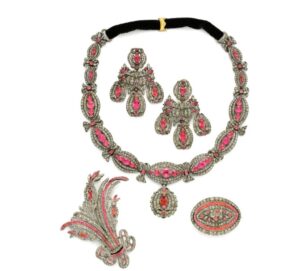
There were the usual gems, the precious ones that we read about a lot. Diamonds, Sapphires, pearls, rubies, emeralds… these were too valuable for Mr. Bennet to give Elizabeth without risking them being taken. Topaz could work, as could garnet, amethyst, or jet. A 4 carat stone of each would be worth:
- Topaz: £5 to £15
- Garnet: £3 to £8
- Amethyst: £5 to £12
- Turquoise: £2 to £6
- Jet: £1 to £4
I needed something that Elizabeth could sell if she found herself in need of escape, but it had to be
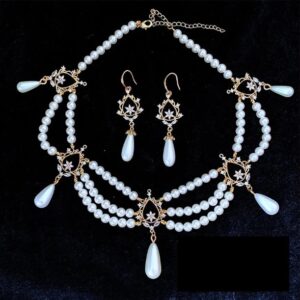
A pearl regency style necklace
something her controlling husband would not confiscate. It also needed to reflect her state of mind—and that of Mr. Bennet. Having been placed in an untenable situation, both struggled with depressed spirits.
After leaning heavily towards jet, which was heavily used for mourning jewelry, I stumbled upon another gemstone: spinel. Spinel is a precious gemstone that is often mistaken for ruby due to its similar color, especially in its red form. However, spinel is a distinct mineral, and its name comes from the Latin word “spina,” meaning thorn, referencing its sharp crystal points. It has been used in jewelry for centuries, but it was often confused with other gemstones like ruby, as they can appear quite similar in color.
It was fascinating, but a 4 carat red spine
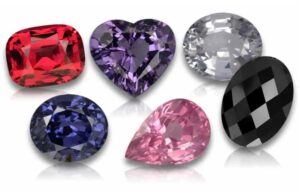
Spinel of all colors
lt would have been taken immediately, especially if it was mistaken for a ruby. Then, I found black spinel. They are described as quite striking, and nowadays it is prized for its rich, deep black color and excellent brilliance. It is an 8 on Mohs hardness scale, making it suitable for use in jewelry, much like its red cousin. Black spinel was less known than red or blue spinel in the 1800s but still ahd a place in fine jewelry.
Jet is a type of lignite (a precursor to coal), jet was popular for mourning jewelry, particularly in the form of brooches, necklaces, and earrings. Its deep black color made it suitable for somber occasions and memorial pieces.
Even better was when I compared a picture of cut jet to cut spinel. They looked very similar, and to an untrained eye, it was easy to assume that the black spinel gem was the less-valuable jet. Can you tell which is which when they are placed side by side?
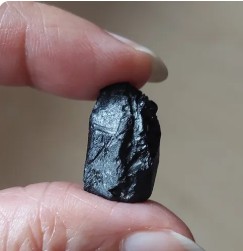
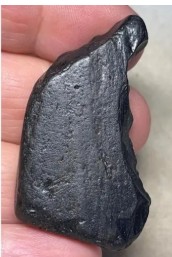
Anyway, I digress…
Here’s a brief summary of the value of Black Spinel. I chose the year 1807 for my search because that is when this particular scene takes place.

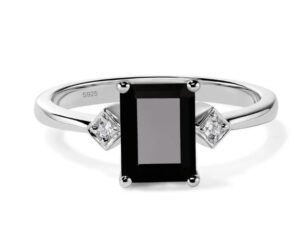
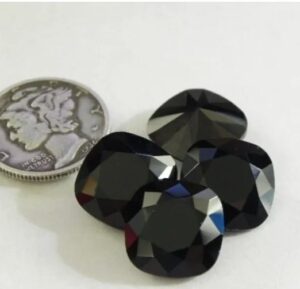
13 comments
Skip to comment form
I don’t know. On the one hand I would say yes because he is an intelligent/shrewd man and Elizabeth is his favorite and would want to protect her. However, knowing how permissive he is of his wife’s antics as well as those of Lydia I could also so him taking a passive approach to life. It could go either way with him, but I’m leaning more towards the first assessment.
Oh my, this just has me in anticipation for your next book!
Author
Fair warning: It’s not in the one coming in March. I’m still working on this manuscript but I couldn’t resist sharing my research rabbit hole!
When you mentioned inexpensive semi-precious stones, the first thing I thought of was amber. Of course, it was probably more plentiful, since they had a whole room of amber in Russia. Also amber would wash up on the coast in Suffolk. So maybe it wasn’t as valuable as it is now.
Anyway, your book sounds interesting. I look forward to reading it.
Author
Thanks! Amber is fascinating for sure. I’ll have to use that in another story.
I don’t know if you saw my review on Amazon or not, but I loved your redemption of Lydia novel. I’m always looking for either sequel, prequel, or missing moment fanfic. I don’t like messing with the original stories very much.
This is a great teaser for your next book! It also reminds me of the fun my daughter and I had exploring the jewelry exhibit at the Victoria and Albert Museum in London. Jewelry is one way to follow the trail of history. It’s a fascinating subject! I can see how you would fall down a rabbit hole. Looking forward to whatever you’re writing!
Author
Thanks! Still working on this story. It will be coming out later this year!
A great teaser! Love the history behind these stones. I love ‘crystals and gems’. I have been following Heather M on FB posts on Jewelry and have started watching the show “Antique Roadshow’, where the most interesting jewelry shows up. I look forward to see how your research fits into your book. 🙂
Author
Thanks! Gem stones are fascinating! I’ve learned a lot about them down this rabbit hole.
That was interesting. Thank you for sharing.
As I was reading this I too was thinking of the jewelry being of better value but “thought” to be something less value to help protect it from being taken. I look forward to how the story turns out.
Love the research and information — and it sounds like quite a novel you’re writing, as well! Thanks, MJ!